The NVIDIA SHIELD Android TV Review: A Premium 4K Set Top Box
by Ganesh T S on May 28, 2015 3:00 PM EST- Posted in
- Media Streamer
- Home Theater
- TV
- 4K
- Shield
- NVIDIA
Graphics Performance
While the SHIELD Android TV and the underlying Tegra X1 SoC are by no means slouches on the CPU side of matters, ultimately NVIDIA is still just another ARM Cortex implementer. On the other hand when it comes to GPUs, this is where NVIDIA truly shines. As NVIDIA is first and foremost a GPU company, and as a design philosophy always invests more time and die space into GPUs than any other SoC builder (save perhaps Apple X-class SoCs), they have always led the pack on GPU performance. And with the Tegra X1 packing a 256 CUDA core implementation of the very potent Maxwell GPU architecture, an estimated 1GHz clockspeed, and all the power and cooling it needs to keep from throttling, all of the ingredients are in place for a very strong showing from NVIDIA for GPU performance.
If there’s any real downside for NVIDIA and the SHIELD Android TV here, it’s that the Android GPU benchmarking situation hasn’t really caught up with what their GPUs are capable of. The standard benchmarks work, but game benchmarks are virtually non-existent, even in the AA and AAA games NVIDIA has helped bring over to the Android/SHIELD ecosystem. So we can’t for example look at the performance of The Talos Principle in the same way as we can the PC today.
Anyhow, we’ll start off with 3DMark’s Ice Storm Unlimited benchmark.
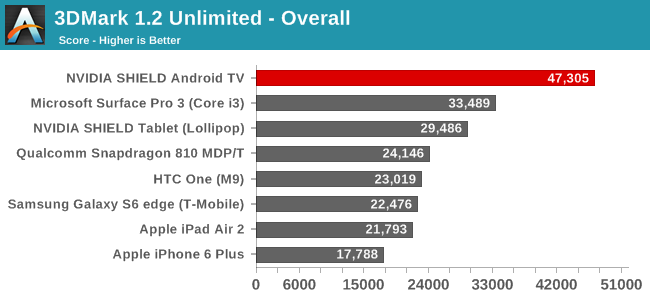
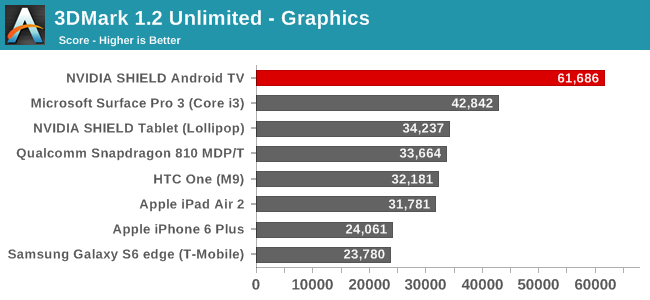
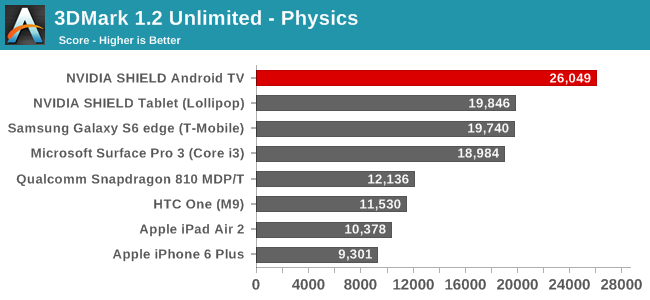
The results here pretty much speak for themselves, especially in the all-GPU graphics sub-score. SHIELD Android TV is 50% faster than the Surface Pro 3 and almost twice as fast as other devices like the iPad Air 2 and the last-generation SHIELD Tablet. Graphics workloads tend to be the most punishing from a heat and power standpoint, and hence are the most likely to get throttled. This really lets the SHIELD and its SoC open up here. At the same time, even in the physics score and the composite overall score, the SHIELD is well in the lead thanks to this combination of factors.
Up next we have BaseMark X 1.1.
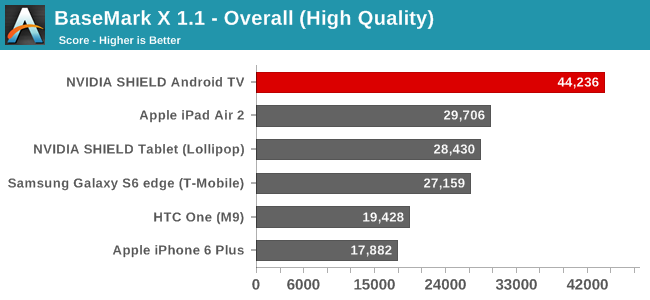
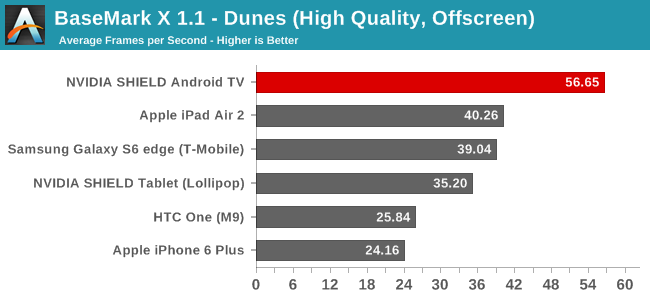

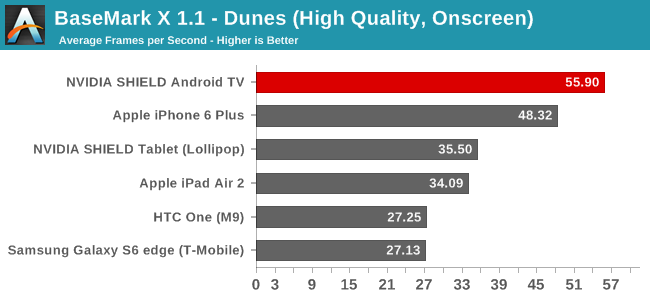
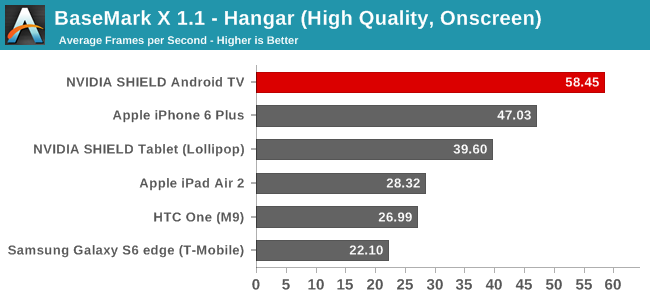
Once more it’s a clean sweep for the SHIELD. Apple’s iPad Air 2 tends to be the second-place finisher, thanks to Apple’s own significant investment in GPU resources, the SHIELD gets yet more resources and the power to fully exploit them. With all of that said, the one thing that does surprise me a bit here is that even the SHIELD can’t crack 60fps on Dunes and Hangar; BaseMark X will likely take one more generation before its tests can be completely beaten.
Our final GPU benchmark is GFXBench.

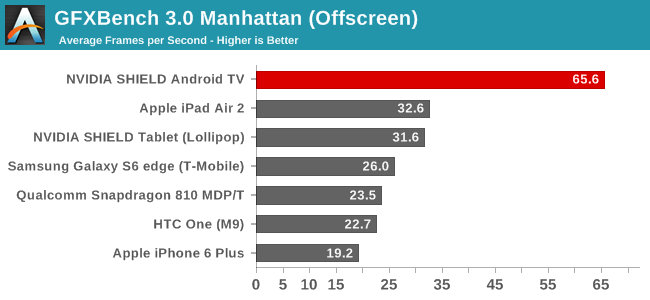
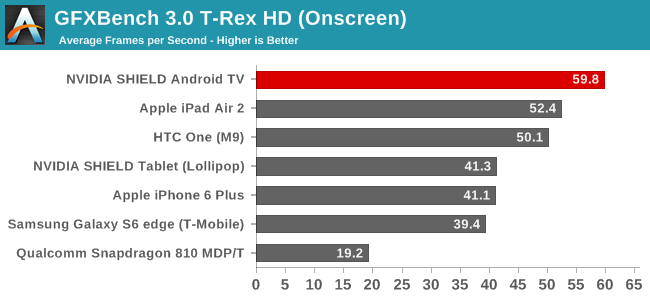
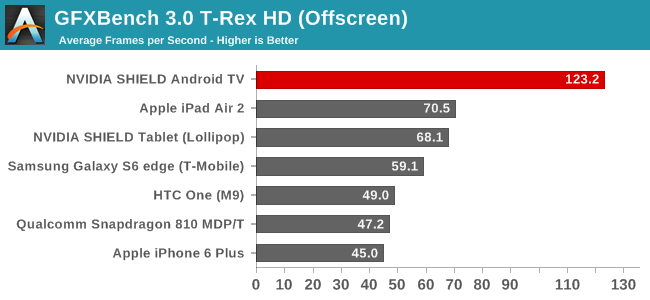
Starting first with the benchmark’s high-level tests, we once again find the SHIELD well in the lead. Of particular note here, the SHIELD Android TV becomes the first Android device to break 60fps on Manhattan, something that as recently as a generation ago seemed impossibly far away.
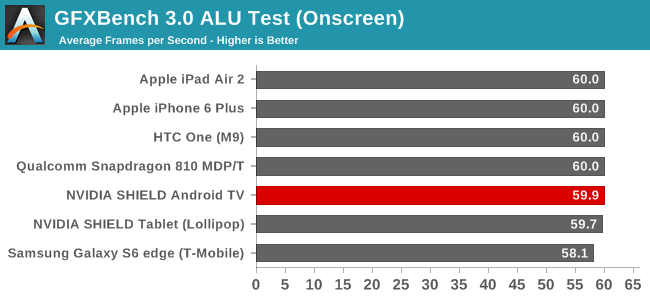
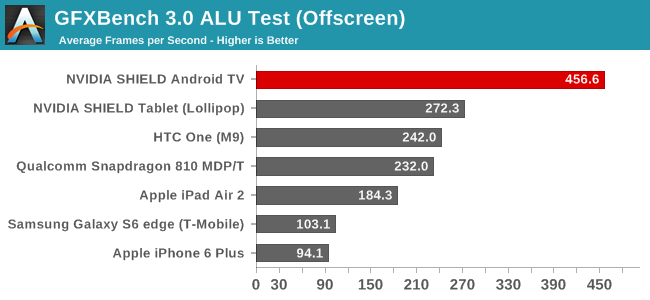

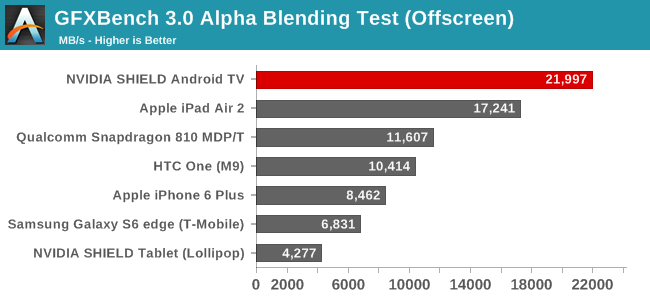
The low-level tests meanwhile offer us an interesting look at SHIELD and Tegra X1 that the high-level tests don’t provide. The ALU test for example drives home the point of just how much in the way of shading resources Tegra X1 has at its disposal (at least when unrestricted), and is a big reason why the SHIELD is doing so well here. On the other hand while NVIDIA still takes the top spot in alpha blending, the lead over the iPad Air 2 isn’t nearly as great, thanks in large part to the iPad’s relatively large 128-bit memory bus. Ultimately SHIELD doesn’t struggle here, but it’s an interesting point of comparison since it shows one of the only cases where SHIELD isn’t a run-away winner, and what kind of graphics workload may eat into its otherwise ridiculous advantage.
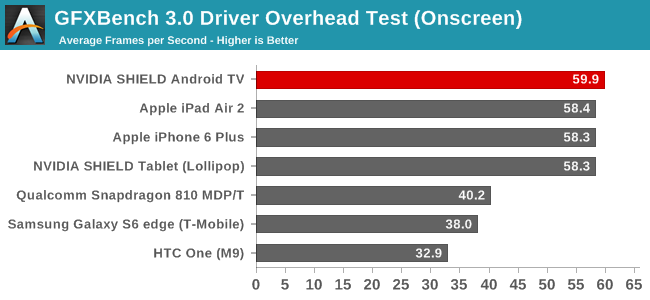
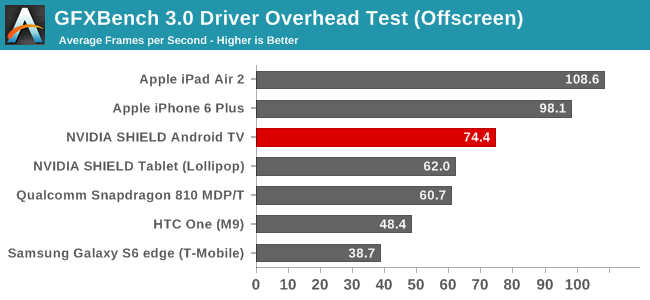
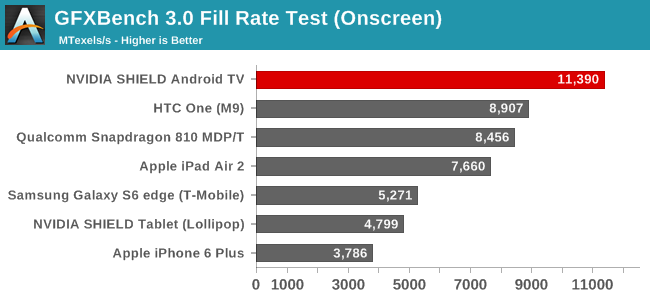
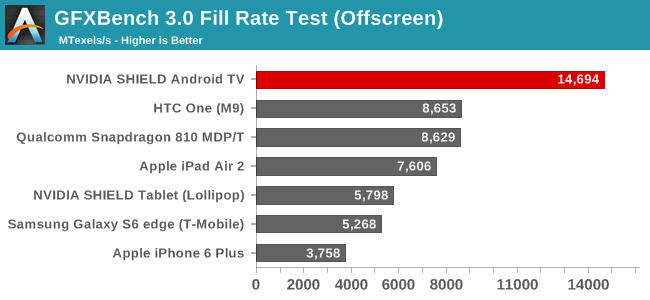
On the last batch of subtests, I’m going to stop again with the fill rate test just to point out another interesting design decision for Tegra X1 and the SHIELD. With NVIDIA banking so much on the set top box’s ability to drive 4Kp60 TVs, NVIDIA needs to push a lot of pixels to get there, as 4K is four-times as many pixels as 1080p. For this reason Tegra X1 is paired with 16 ROPs, giving it low-end PC desktop-like pixel throughput, and of course a huge advantage in the GFXBench fill rate test. And though this fill rate will help with games as well, it’s keeping up with the Android UI at 4Kp60 that is the most important reason for all of this fill rate performance.
Wrapping things up, what else is there to say about the SHIELD Android TV’s GPU performance? What we’re looking at here is twice as fast (or more) than the best phones and tablets today, a combination of the Tegra X1’s very strong GPU design and the set top’s practically unlimited energy and cooling capabilities. Overall NVIDIA is following the path they started long ago on Tegra, always favoring strong GPU performance, leading to the incredible performance we’re seeing here.
With that said, given NVIDIA’s decision to focus on the Android TV aspects of the SHIELD Android TV first and foremost – and not gaming – it’s also fair to say that the SHIELD is overpowered for Android TV work. Other than keeping up with the basic pixel fill needs of 4K, the real power of the box’s GPU is going to be left untapped by Android TV (especially on the ALU side). Which makes all of this humorously absurd in a way, but it’s also why SHIELD Android TV isn’t just an Android TV box. The device’s GPU performance will be put to good use with gaming, though stepping outside the world of benchmarks for a second, the bigger challenge NVIDIA faces is not delivering high performance, it’s delivering games that make full use of that performance.










167 Comments
View All Comments
hero4hire - Monday, June 1, 2015 - link
The question is not a matter of capablability but of utility. A $20-$30 chromecast does most of the functions. A smart TV by itself can do some. The Shield is a luxury device. Using nothing or a Roku on bottom to a ps4 or a htpc on top. Fitting in the middle and attacking a niche is this product.What does the more capable processor provide I've alternatives and am I willing to pay a little more for significantly more capability? That's the value question.
Yojimbo - Thursday, May 28, 2015 - link
"Though it’s a bit of circular logic to say that NVIDIA is intending to exploit these same advantage in the SoC space as they have the desktop space – after all, Maxwell was designed for SoCs first – Maxwell’s capabilities are clearly established at this point."There's a difference between circular logic and redundancy (much like there is a difference between circular logic and a tautology). To say that NVIDIA is intending to exploit the power-efficiency in the SOC space is simply redundant after you already said that NVIDIA designed the architecture that way in the first place. The citing of power efficiency in desktop products is simply giving evidence of power-efficiency. There's no implication of EXTRA power efficiency more than what was originally designed in the architecture by moving from desktop GPUs to the SOC GPUs. How can circular logic appear when no implication is being made?
testbug00 - Thursday, May 28, 2015 - link
"Ultimately it’s clear that the SHIELD Android TV is heavily overspeced compared to other Android TV devices – no one else is pursuing this premium market..."Perhaps because the market isn't large enough to justify a product aimed solely at it? Nvidia can leverage their streaming GPU stuff and a bunch of other stuff no other players really have.
Even with that, I don't think the market is large enough to support one player.
UltraWide - Thursday, May 28, 2015 - link
If I use a receiver and send the audio via bitstream to the receiver, will it play or not? I don't see why bitstreaming of audio requires a license? I thought the license is only required to actually decode the audio on the device and play some downmixed version of it.ganeshts - Thursday, May 28, 2015 - link
Try convincing Dolby, DTS and NVIDIA together :) I am with you on this one, but NVIDIA says licensing is the issue.cfenton - Thursday, May 28, 2015 - link
How does it handle external storage of apps? Android has typically been OK about reading media from an SD card, but it's recently been more and more restrictive about how apps can interact with external storage. Does Android TV (or some Nvidia custom magic) solve that problem? With only 16GB internal (and surely less user accessible) it will quickly run out of room if you want to install games. Recent experience with an Xperia Z3 and Nvidia Shield Tablet have not been promising on this front, at least without root access. The Xperia will copy some data to the external storage device, but still leave some on the internal, and the Shield Tablet is really picky about what games it will transfer to external storage. I'd want to just plug a 2TB portable drive into this thing, have it install everything there, and never think about it again, but based on past experience I'm worried that won't work.I know they want people to use GRID, but until data caps go away that won't be practical in many places.
Ryan Smith - Thursday, May 28, 2015 - link
The SATV can handle apps on SD cards. In fact it has a feature to automatically move newly downloaded apps to the SD card in order to better utilize the space it provides.docbones - Thursday, May 28, 2015 - link
Application support is going to be the biggest item. Will it be updated to run current Amazon Prime, Max Go, HBO Go, CW streaming, etc.Currently none of the Android TV type devices have parity to the number of streaming video apps that my phone does.
chizow - Thursday, May 28, 2015 - link
I didn't have much interest in this product or any of the previous Shield products, but with Windows Media Center's impending doom with Win10 and the prospect of Silicon Dust's HD HomeRun DVR as a viable replacement, I may have to look into getting one.It certainly seems to pack a lot of value and possibilities into a very small price tag of $200. I'm just not sure on the naming/branding, but I guess they think the Android TV aspect may have a higher demand than some of the gaming initiatives they are slowly building upon.
testbug00 - Thursday, May 28, 2015 - link
they really should make a $150 version that is just the console. Probably would increase sales quite a bit... Although, the controller and stuff is probably well under $50 to make however.